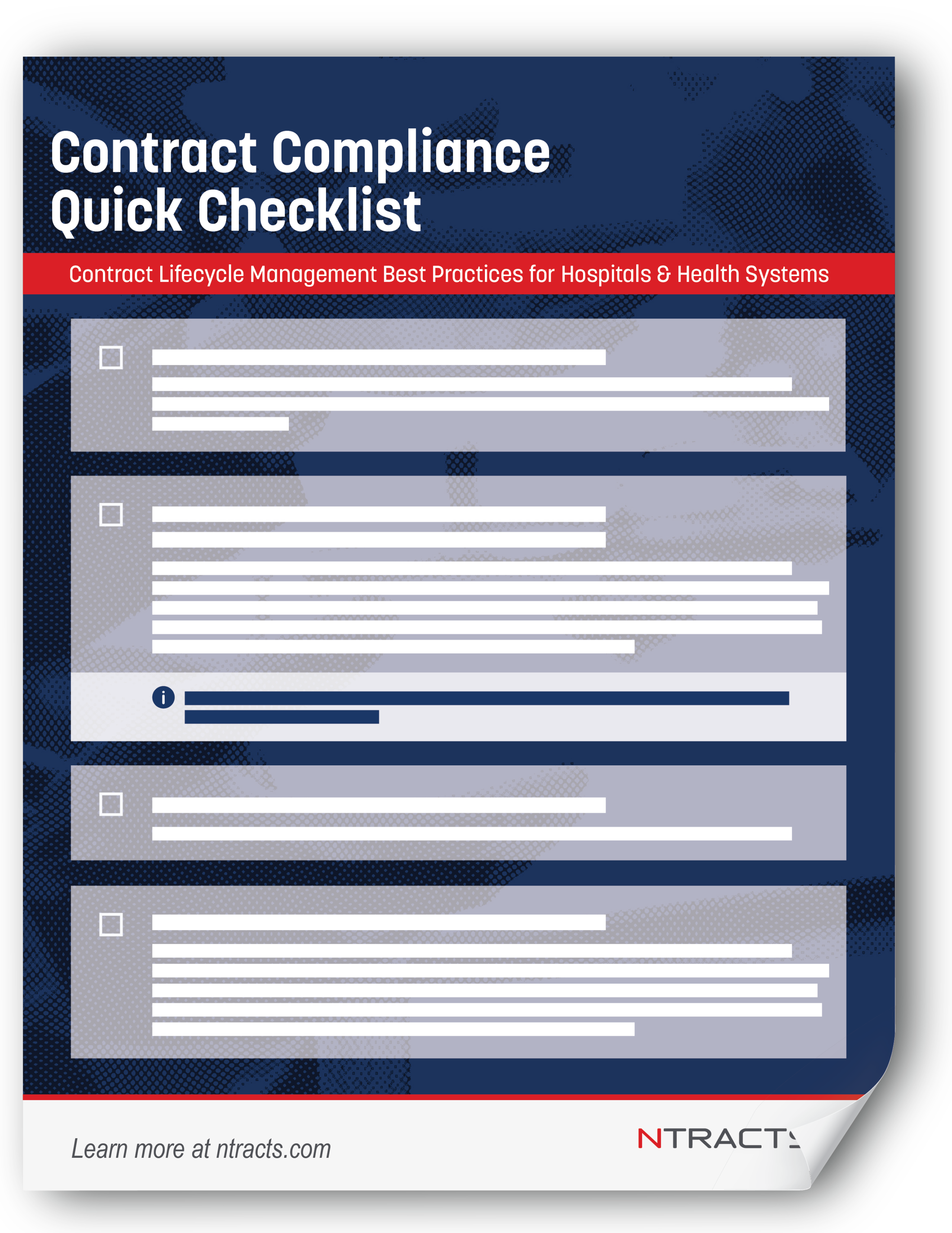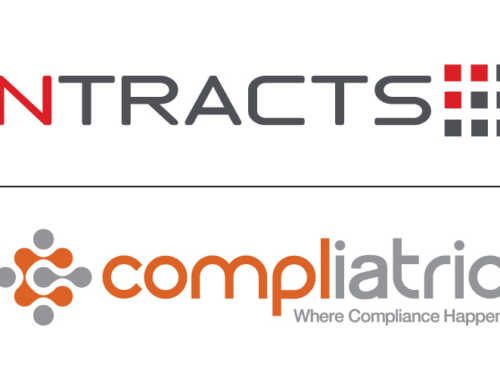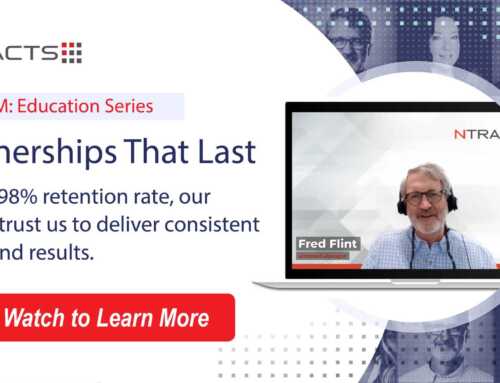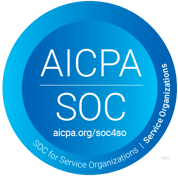
A robust Contract Lifecycle Management (CLM) system is one of the most critical needs for healthcare organizations to achieve and maintain compliance. However, not all CLM solutions are created equal. Any missing key feature from those covered in this article, can put an organization at significant risk.
Below is a breakdown of the essential elements every healthcare organization should ensure their CLM solution provides so users can have confidence in maintaining organizational and regulatory compliance and security to contracts, supporting documents and data.
Key Features of a Healthcare-Specific CLM Solution include:
- Required Data Points
- Automatic Notifications
- 3-Tiered Security Model
- Contract Records’ Relationship to Vendors and Files
1. Required Data Points, Comprehensive Data Tracking
The foundation of any CLM system lies in its ability to track data points accurately. Beyond simply tracking data points, a CLM appropriate for healthcare organizations should go even further – it should require that specific and essential datapoints are entered to ensure proper monitoring and tracking of all contractual obligations.
Requiring this data, ensures that critical information is captured, and that there is virtually no risk of oversight or error when it comes to effective, expiration and other key critical dates, in particular, related to the contract. Mandatory data points also standardize contract entries, making it easier to generate accurate reports and conduct audits.
Moreover, having required data points helps in maintaining compliance with regulatory standards, as it guarantees that all necessary details are documented and readily available for review if needed to provide evidence of compliance. Many non-healthcare CLM platforms do not require entry of key data points, which puts the organization at risk.
At a minimum here are the required data points we recommend (and track):
- Parties to the Contract: Clearly identify internal and external parties involved in the agreement. This helps in understanding all parties to the agreement.
- Effective & Expiration date: Proper tracking of these dates ensures timely actions on upcoming contract renewals and terminations, preventing lapses in contract term and compliance.
- Contract Status: Implementing a simple, yet effective status system (e.g., incomplete, active, expired, closed statuses) ensures that contracts are properly monitored throughout their lifecycle. Whereas very granular status options can cause confusion and can create more problems in monitoring than they are trying to solve.
- Auto-renewal clause, if applicable
- Auto-renewal terms / times
- Termination / Out clauses
- Contract is Fully Executed: Knowing whether a contract is fully executed is crucial before any payments are made. This prevents unauthorized transactions and ensures all agreements are legally binding. As it relates to physician agreements, services cannot be performed prior to the effective date of a fully executed agreement, this field is key to ensuring that compliance in maintained.
- Contract Responsible Parties
- Primary Contract Type and Department: These fields help in categorizing contracts accurately, allowing for better organization, reporting and control of user access permissions. Departments and contract types should be tailored to meet the specific needs of healthcare organizations.
When AI tools are used for data entry, contracting and compliance professionals must ensure that manual oversight remains vigilant. Regardless of the method of entry, many data points must follow a particular format in order for other features in the solution to work properly.
For example, an expiration date that is reviewed and entered by an AI tool within another system often falls into a default text-based field rather than a date-picker field. A date entered as text, often cannot be included in reporting instances and or used to properly identify the date upon which to send notifications.
2. Automatic Notifications
Automatic notifications are a crucial feature in a Contract Lifecycle Management (CLM) solution. Particularly for healthcare organizations. The ability to send automatic notifications for critical dates, such as upcoming expirations or renewals, ensures that contract owners are always aware of important deadlines and can take necessary actions promptly. This is especially important for managing auto-renewing provisions, as missing these deadlines can lead to unintended contract extensions or renewals..
These notifications should be sent via email and through in-app alerts to ensure that contract owners receive timely reminders. Email notifications provide a direct and easily accessible way to keep track of critical dates, while in-app alerts offer real-time updates within the CLM system itself, allowing users to take immediate action if needed.
Additionally, the CLM system should have the capability to summarize upcoming critical dates via daily push emails. These summary emails provide an overview of all pending tasks, ensuring that contract owners are consistently updated on all important critical dates including contract expirations, auto renewals and other upcoming deadlines. This daily digest helps users prioritize their tasks and workload, reduce the risk of missing critical dates, enabling them to maintain a proactive approach to contract management.
3. Robust Security Model
Security and access to data is a top concern in healthcare, and a Contract Lifecycle Management (CLM) system must provide a multi-tiered security model to control and maintain access effectively. This model ensures that sensitive data is protected and only accessible to those who need it, thereby ensuring confidentiality and preventing data breaches.
The security model should include restrictions based on internal entities, contract types, and departments. Access should be limited to users within specific organizational units or departments, ensuring that only individuals directly involved in a particular area of operations can view or modify the contracts related to their function, thus reducing the risk of unauthorized access. Additionally, different types of contracts—such as vendor agreements, clinician contracts, or service agreements—often contain varying levels of sensitive information. By restricting access based on contract type, the system ensures that only relevant personnel with the appropriate authorization can view and manage these documents. Furthermore, department-based access control ensures that sensitive information is compartmentalized and accessible only to those within the appropriate department. Examples include restricting financial agreements to finance personnel, clinical contracts to clinical management teams and physician agreements to the physician enterprise.
A comprehensive securing model includes implementing strong authentication measures and conducting regular access reviews to ensure compliance with security policies. Protecting sensitive information from unauthorized access is essential for maintaining confidentiality, especially in healthcare, where contracts often contain private and legally protected information. Ensuring that only those with a legitimate need to know and access certain information can do so, helps maintain the trust and integrity of the organization
Multi-tiered security vs. single-tiered:
When CLMs offer the same permissions to all users, healthcare organizations must then create work-arounds to remain compliant. For example, when using a contract management system with a single tiered security option, compliance professionals might determine it’s best to keep their physician agreements in an entirely different system rather than in the same system their service contracts are stored within. This impacts oversight of contracts throughout the organization, thereby making maintaining compliance more difficult – given all agreements in healthcare are subject to some type of regulatory compliance and oversight.
Overall, a multi-tiered security model in a CLM system is essential for protecting sensitive information, maintaining compliance, and ensuring that only authorized personnel have access to critical contractual data. This approach not only enhances security but also supports the efficient and secure management of contracts within healthcare organizations.
4. Detailed Contract, Document, and Record Relationships
An effective CLM system should allow for detailed tracking of relationships between contracts, vendors, and files. It should provide the option to associate a single file with multiple contracts, streamlining document management.
Linking contract records with internal and external parties, along with its related files, is pivotal for contract management efficiency. Associating records, allows for a comprehensive view of all agreements and related documents, fostering seamless collaboration and communication between all involved stakeholders.
By creating these connections, organizations can ensure that every relevant document and party is easily viewable and accessible, reducing the time and effort spent searching for information. This linkage streamlines contract administration, aids in identifying overlaps or gaps in agreements, and supports more informed decision-making by enhancing transparency.
Conclusion
With the regulatory rigor surrounding healthcare organizations, it becomes crucial to partner with a contract lifecycle management solution that understands healthcare and how the essential features covered here are specifically necessary for healthcare organizations to maintain compliance and mitigate risk.
By setting a strong foundation with the basics, your organization can not only mitigate risks, but also build a more efficient and compliant contract management process for years and decades to come. The goal is not just to manage contracts but to leverage your CLM solution to maintain regulatory and organization compliance and drive insights and innovations that support your organization’s broader goals.
About Emily
With 9 years of healthcare CLM experience, Emily Danek has a passion for building teams and solving clients needs with technology. Emily has been at
Ntracts since May of 2019 and has spent time working with clients, supporting their use of Ntracts’ solution. She also spends a portion of her job working with employees to support their departments and growth initiatives.




![[Webinar On-Demand] Compliance Program Effectiveness: From Mystery and Mayhem to Mastery and Metrics](https://www.ntracts.com/wp-content/uploads/2025/01/WOD-Thumbnail-scaled-500x383.jpg)

